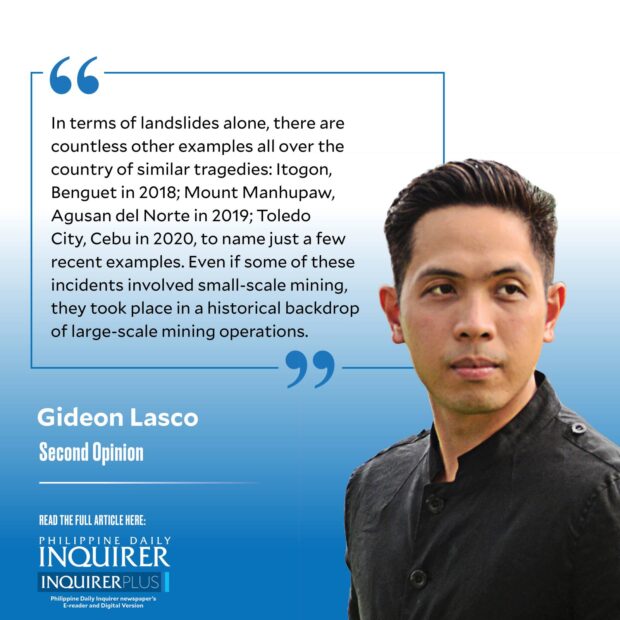The slow violence of mining

As I write this, the death toll stands at 98 in the landslide at Barangay Masara in Maco, Davao de Oro, which occurred after heavy rainfall last Feb. 6. As distant as the possibility of experiencing such a cataclysmic event may be for many of us, try to imagine its sheer terror: the earth rumbling, rocks tumbling, trees, boulders, vehicles, infrastructure, water, and soil being carried away, and moments later, entire houses destroyed, burying humans and animals alike.
There is no such thing as a natural disaster, and this tragedy exemplifies this truism: heavy rainfall cause landslides no more than heart attacks cause death. In other words, while it may be the immediate mechanism that led to the fatalities, it is unlikely the meaningful or substantive reason why the landslide happened. To explain this catastrophe, we need to probe deeper.
Formerly known as Compostela Valley, Davao de Oro is a province I’ve had the privilege of visiting a number of times and I have seen how the forested mountains—which include some of the most beautiful mossy forests I’ve seen—have cradled communities and allowed them to thrive from the natural resources. But I have also seen how the destruction of those mountains have rendered entire communities vulnerable to even modest amounts of rainfall. There are many reasons for this vulnerability, including the poverty and land insecurity, that leads people to build houses in precarious areas. But one big factor is gold—the “oro” in the province—and how it has been pursued relentlessly for profit, but in a way that has compromised people’s lives and livelihoods.
In the case of the Maco landslide, Apex Mining—which has a gold mine near the landslide and whose workers were among those who perished—was quick to distance itself from the tragedy, saying that it happened outside their area of operations. The Department of Environment and Natural Resources’ Mines and Geosciences Bureau in the region has confirmed this claim, seemingly exonerating the mining company and attributing the landslide instead to “continuous heavy rainfall” accompanied by factors like “occurrence of earthquakes and the steep terrain.”
However, as Interfacing Development Interventions for Sustainability (Idis), a Davao-based NGO, pointed out in a statement, there are important questions to raise, including to what extent underground mining has affected the broader landscape beyond its scope of operations. After all, it is a well-established fact in the geosciences literature that, as a 2017 article in Engineering Geology put it, “When a mining operation is performed beneath mountainous or hilly terrain, it may trigger landslides.”
“… it is crucial to acknowledge the wider context of environmental hazards linked to the mining operations of Apex, regardless of their direct role in the Masara landslide,” the Idis concluded.
—————-
Beyond the Masara landslide, the mechanisms of how mining adversely affects communities—geologically, environmentally, economically, politically, and socially—need to be revisited and acted upon by the national government, especially as the climate crisis adds another layer of vulnerability to the environment via increasing rainfall and changing storm patterns, and as the noncompliance by mining firms and the failure—willful or not—of government to enforce its own rules continue.
In terms of landslides alone, there are countless other examples all over the country of similar tragedies: Itogon, Benguet in 2018; Mount Manhupaw, Agusan del Norte in 2019; Toledo City, Cebu in 2020, to name just a few recent examples. Even if some of these incidents involved small-scale mining, they took place in a historical backdrop of large-scale mining operations.
Aside from landslides and soil erosion, there are many other environmental impacts of commercial mining operations, including soil and water pollution, forest loss, and sediment deposition. Several years back, widespread mercury poisoning was detected in two Palawan villages decades after an open-pit mine operated in the area, pointing to the temporal scale of these adverse impacts. Like the oil spills in Guimaras and Mindoro, they constitute what we can call “slow violence,” defined by the environmental humanities scholar Rob Nixon as “a violence that occurs gradually and out of sight, a violence of delayed destruction that is dispersed across time and space, an attritional violence that is typically not viewed as violence at all.”
Thankfully, people around the country are calling out this violence for what it is, despite facing the risk of very real violence, harassment, or Red-tagging in the process. They include Sibuyanons who recently celebrated the anniversary of having blocked mining in their island through a “people’s barricade”; Palaweños who are currently resisting the nickel mining in Brooke’s Point which has continued despite a Supreme Court writ of kalikasan; and Davaoeños who are rallying for accountability for the Masara landslide today.
The least we can do is echo their call.
—————-
glasco@inquirer.com.ph





















